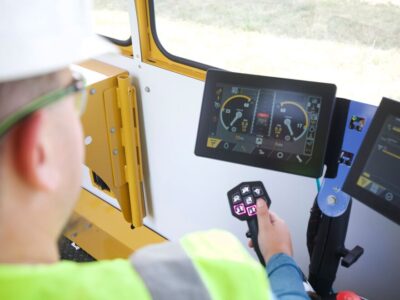Demand for long and large-diameter pipe installations continues to grow. Completing this work requires horizontal drilling efficiency. A larger drill pipe is more rigid with limited steering deflection. Operators must precisely follow a preplanned bore path to avoid aggressive steering changes.
“The steering and guidance systems are very precise,” says Gary Castleberry, senior construction consultant with GeoEngineers. “Crossings that you couldn’t do, 13,000 ft. (3,962m), 14,000 ft. (4,267 m), 15,000 ft. (4,572 m), are now being done [using intersect drilling with two drills].
Rocky soils may complicate the process. The hardness and unpredictability of rock formations can require operators to make constant adjustments to avoid stalling the drill string. Balancing power and control in these conditions often leads to operator overcompensation and inconsistent performance. Selecting the right downhole tooling is also a critical factor in achieving horizontal directional drilling efficiency in these challenging conditions.
Vermeer horizontal directional drills (HDDs) incorporate several features that maximize bore precision in demanding pipeline applications, including ultra-slow speed control and AutoTension.
Precise thrust control provides consistent performance
Optimal drilling in challenging rock bore conditions requires the operator to maintain the maximum allowable weight on the bit while preventing frequent rotational stalls. This becomes difficult when drilling through unpredictable and inconsistent rock formations.
Balancing power and control when drilling in rock conditions can be challenging. Vermeer continues to fine-tune slow speed control developed to give the operator precise control over the drill’s thrust. Ultra-slow speed control, introduced with the launch of the next generation D550, allows the operator to drill closer to the drill’s limits without the risk of stalling. Speed and power are adjusted to maintain a constant weight on the drill bit. Slow speed provides greater control over the drill bit, leading to improved horizontal directional drilling efficiency.
“It’s not necessarily about slow speed; it’s really about controllability,” said Clint Recker, product manager for Vermeer. “It’s the ability to adjust the speed and power of the drill to maintain a constant weight on the drill bit, allowing optimal cutting performance and efficient drilling.”
Lower rotational speeds enable precise management of thrust on the drill bit. This results in better steering and navigation in inconsistent or varying rock conditions.
Tension keeps reamers centered
It is becoming more common to position a drill rig on each side of a large diameter or long intersect bore. After completing a pilot bore, the two drills can work together to increase the efficiency of the reamer passes.
Vermeer simplifies the connection of two drill rigs working on intersect bores with the AutoTension feature. When activated, AutoTension maintains a steady tension force on the tail string. This can help keep the reamer positioned in the center of the hole and minimizes the chance of the reamer keyholing the borehole. It helps streamline large diameter and long-distance bores by increasing the efficiency of reamer passes.
“Vermeer AutoTension allows crews on the entry and exit side of the bore to work together while reaming or swabbing the borehole,” said Klein. “This leads to more efficient and accurate reamer passes without the need for a mechanical locking swivel.”
With AutoTension, operators can connect directly to the HDD on the exit side and set back the tension needed to centralize the reamer without having to manually engage the joystick. It maintains the desired tension on the tail string throughout the drilling process. The driving machine can switch between pushing and pulling without requiring action from the operator in the other drill.
“In certain subsurface ground conditions, being able to pull the reamer from both directions can reduce risks of high pressures and inadvertent returns,” said Castleberry. There are a lot of benefits. “We see some smaller crossings done with intersects because it is considerably faster.”
The AutoTension feature is currently available as an option on either the Vermeer D220x500 S3 or Vermeer D550 HDDs.
Horizontal drilling efficiency on long, large-diameter projects is built on a combination of equipment, features and operator technique. These projects require a mix of planning and precision. Vermeer innovations like ultra-slow speed control and AutoTension maximize operator control of the drilling process. This translates to efficient, accurate and timely product installments.
To learn how Vermeer technology can benefit your next pipeline project, contact your local Vermeer dealer for guidance.
Vermeer Corporation reserves the right to make changes in engineering, design and specifications; add improvements; or discontinue manufacturing at any time without notice or obligation. Equipment shown is for illustrative purposes only and may display optional accessories or components specific to their global region.
Please contact your local Vermeer dealer for more information on machine specifications. Vermeer and the Vermeer logo are trademarks of Vermeer Manufacturing Company in the U.S. and/or other countries.
© 2025 Vermeer Corporation. All Rights Reserved.
